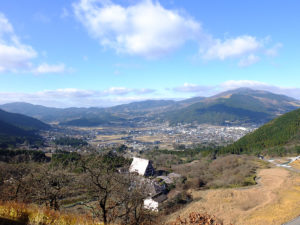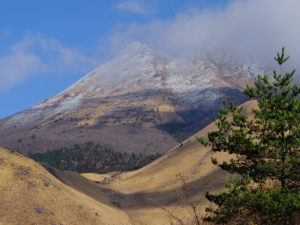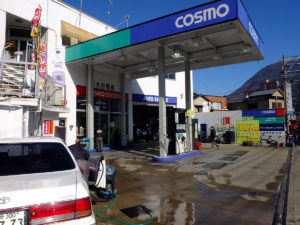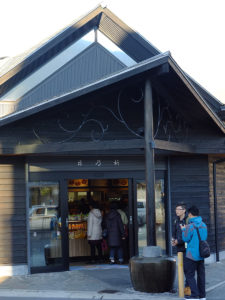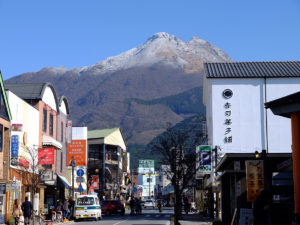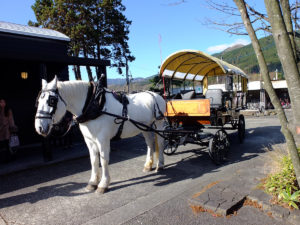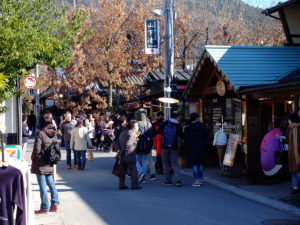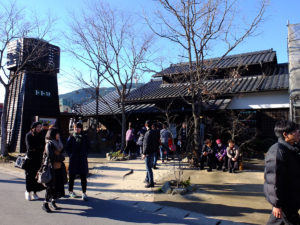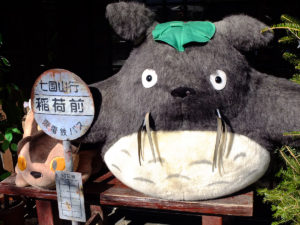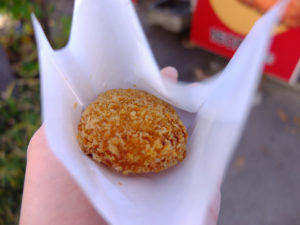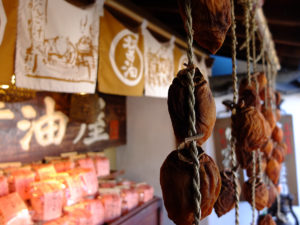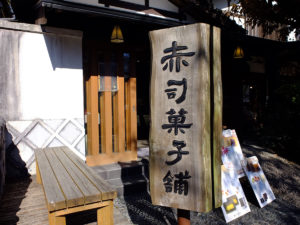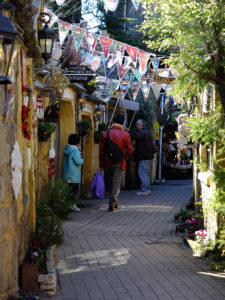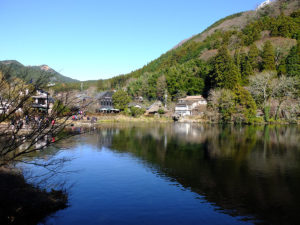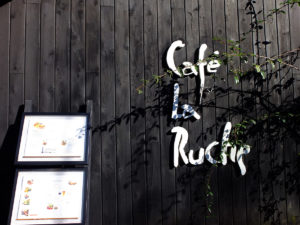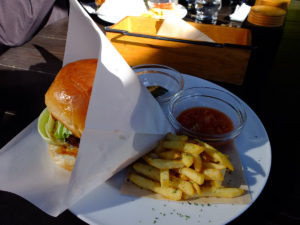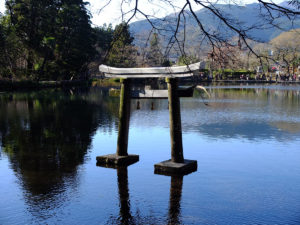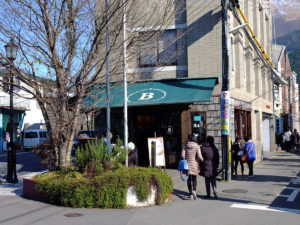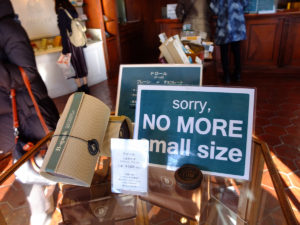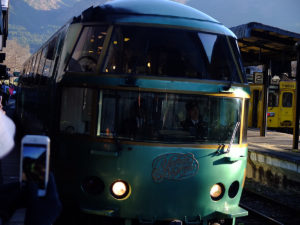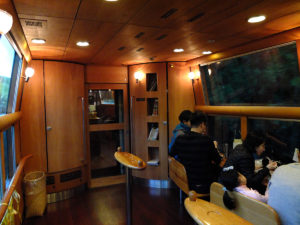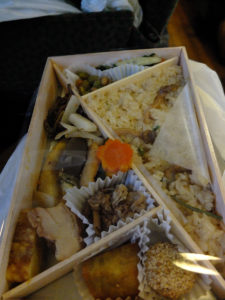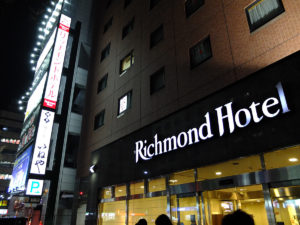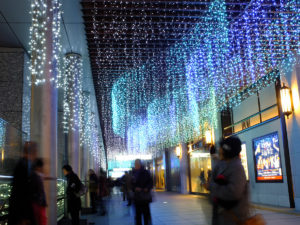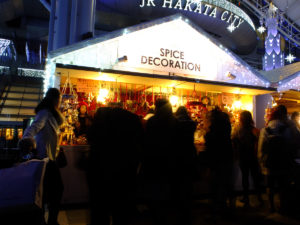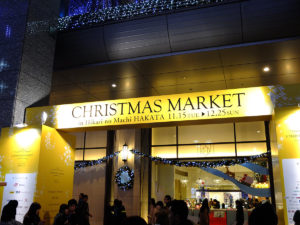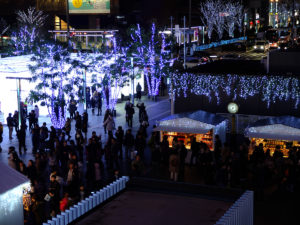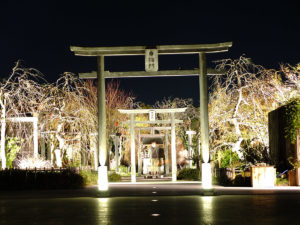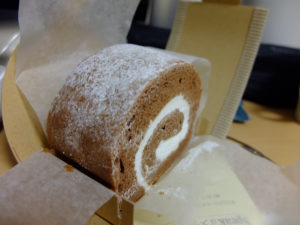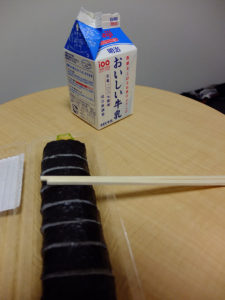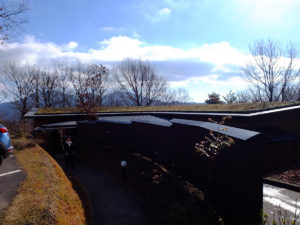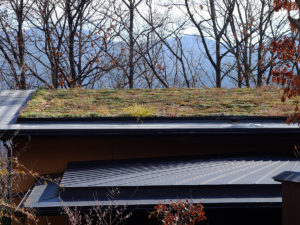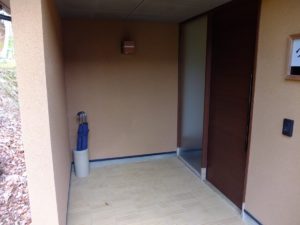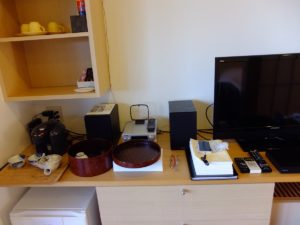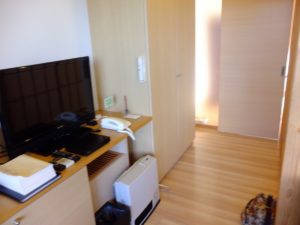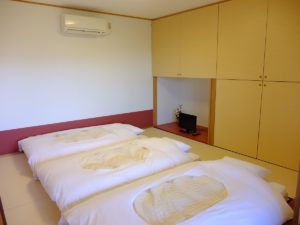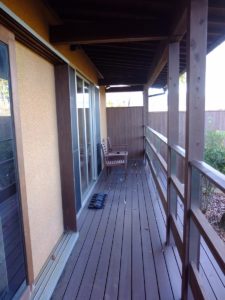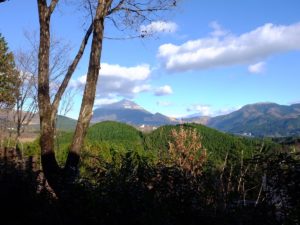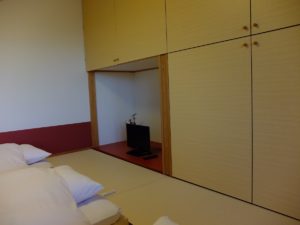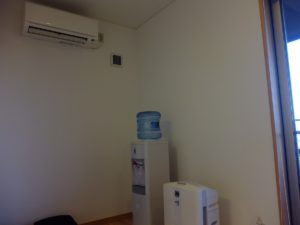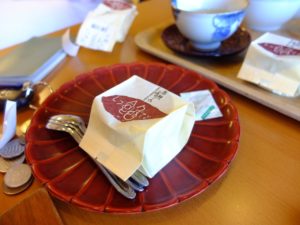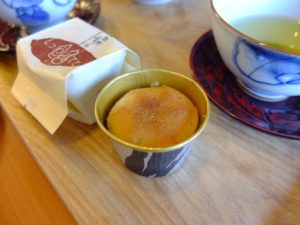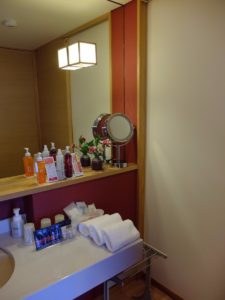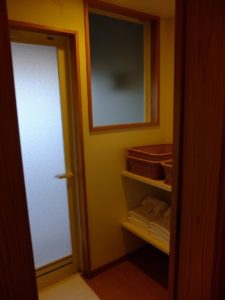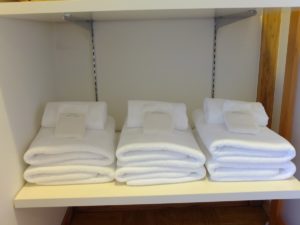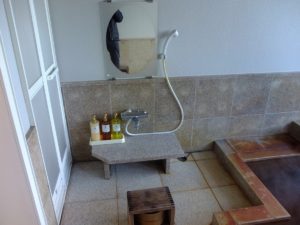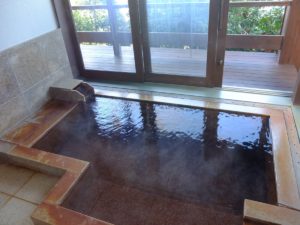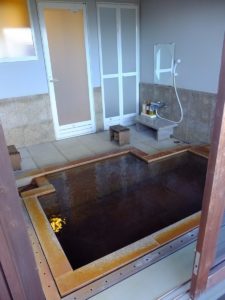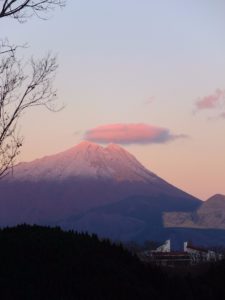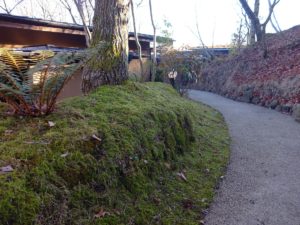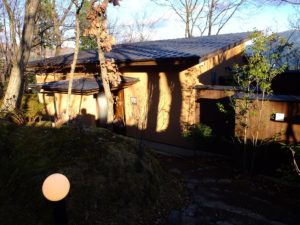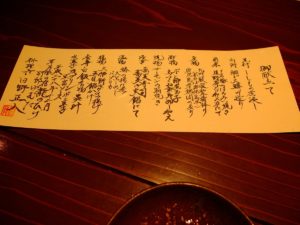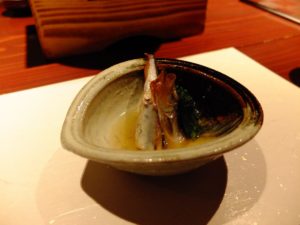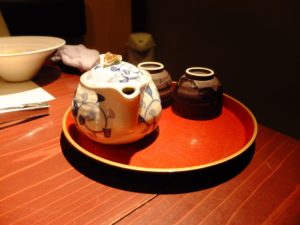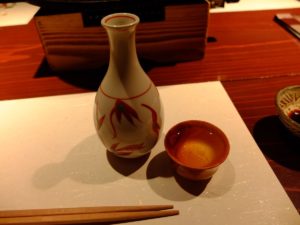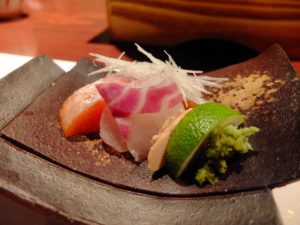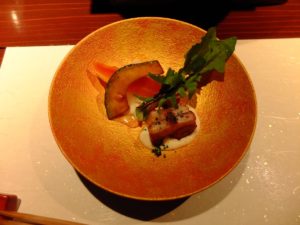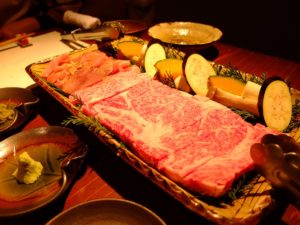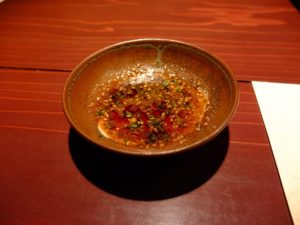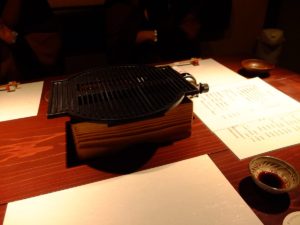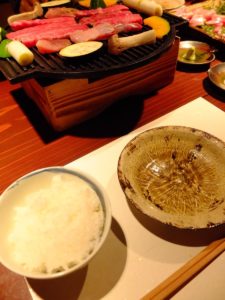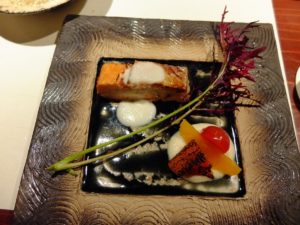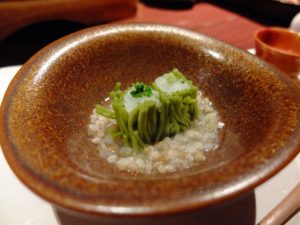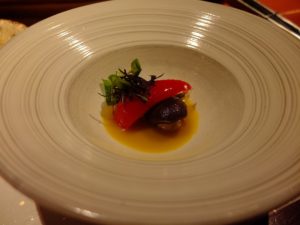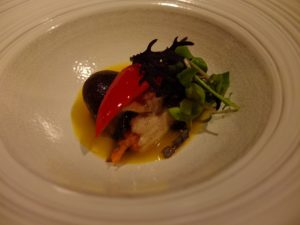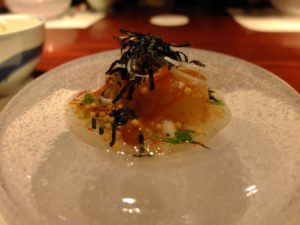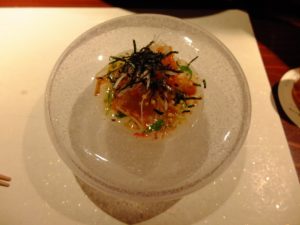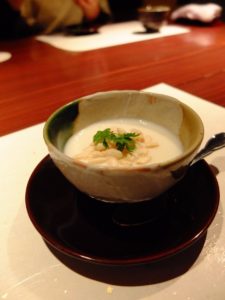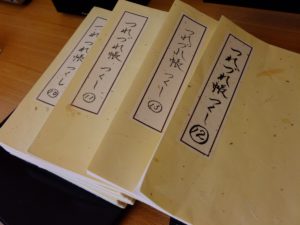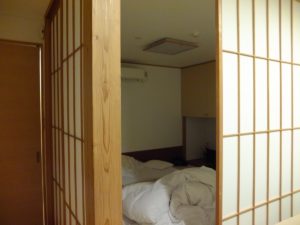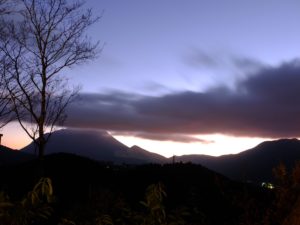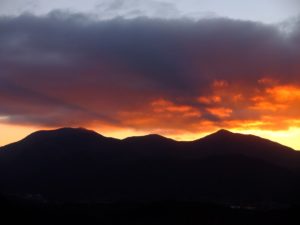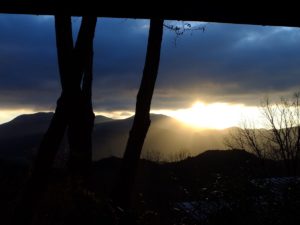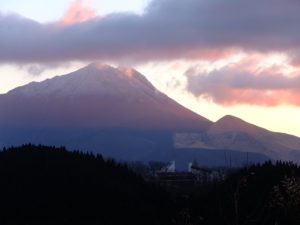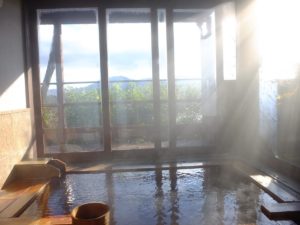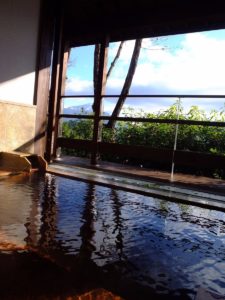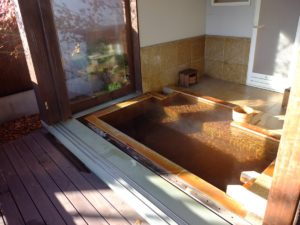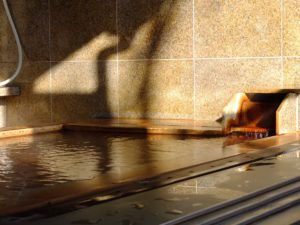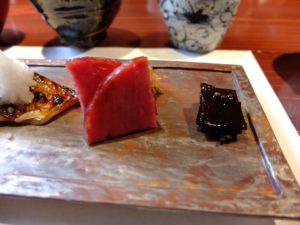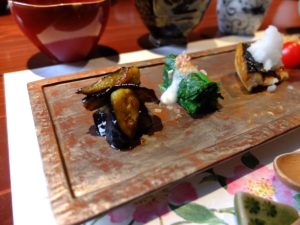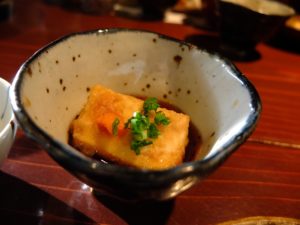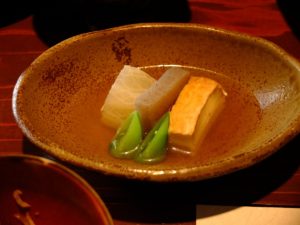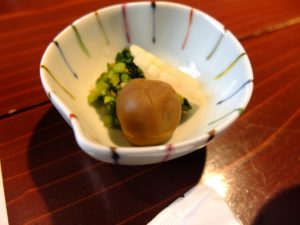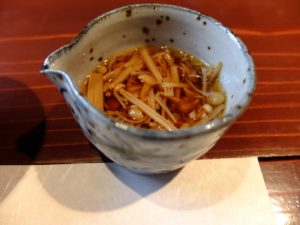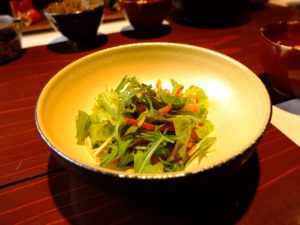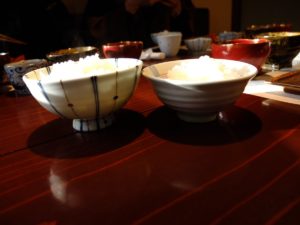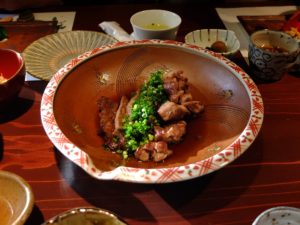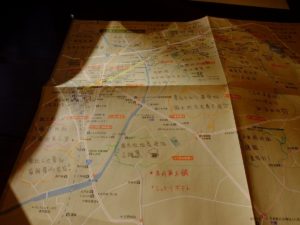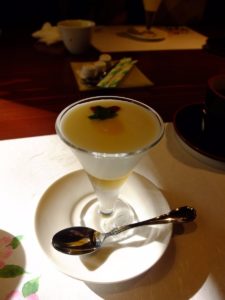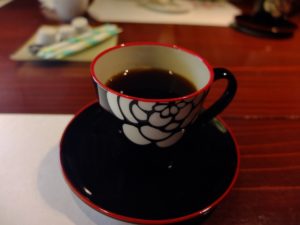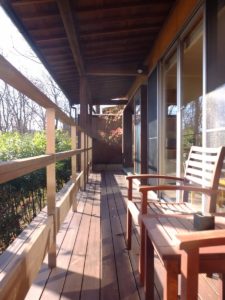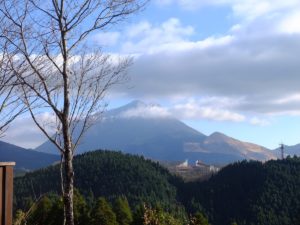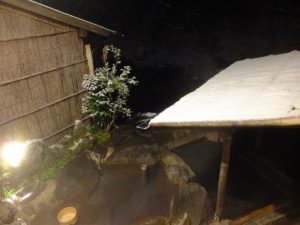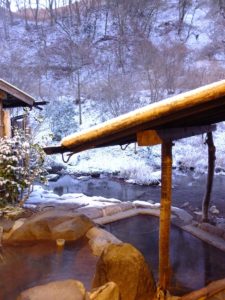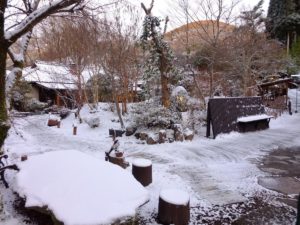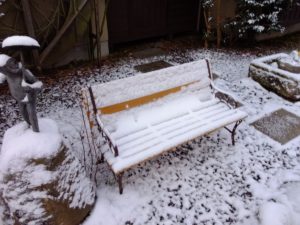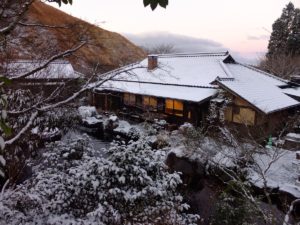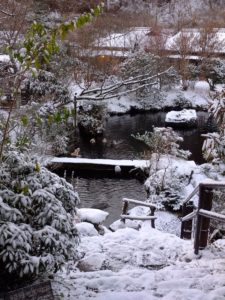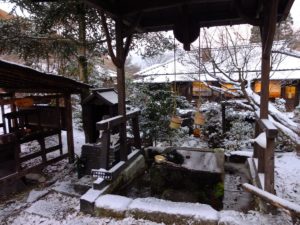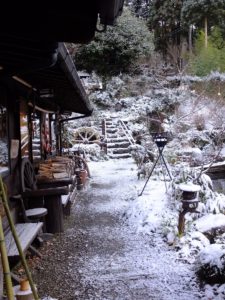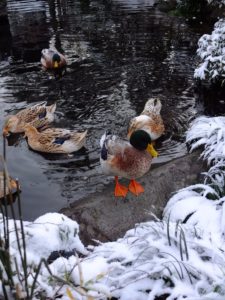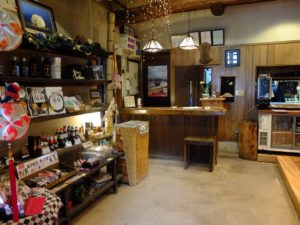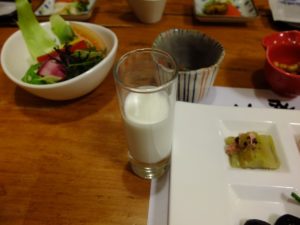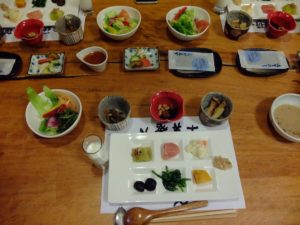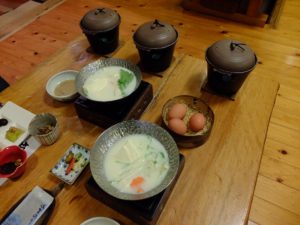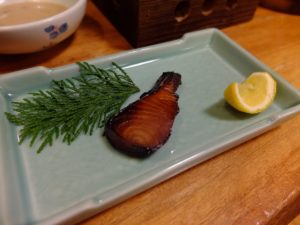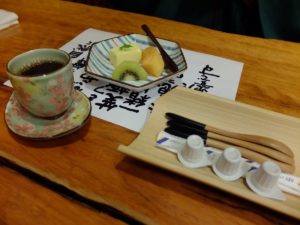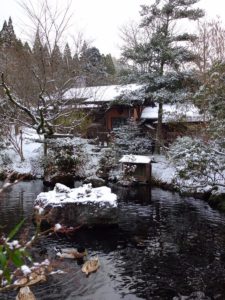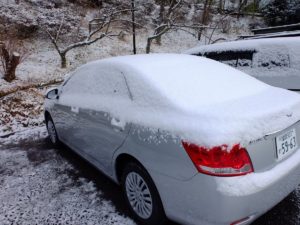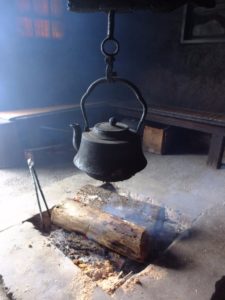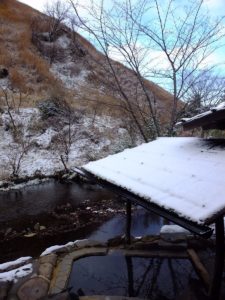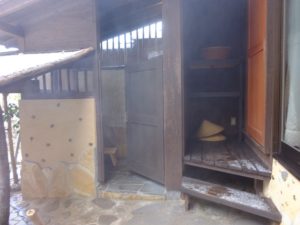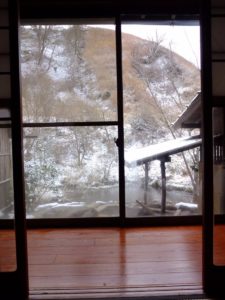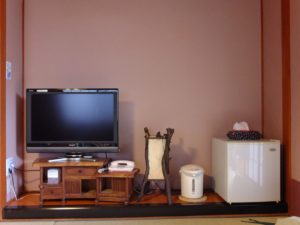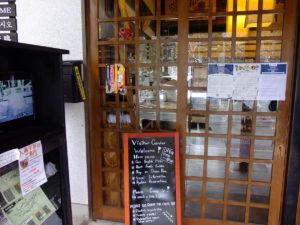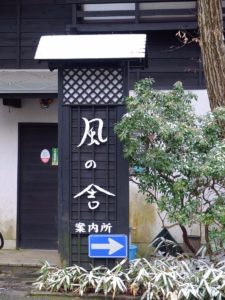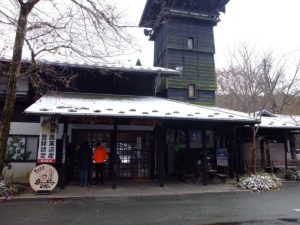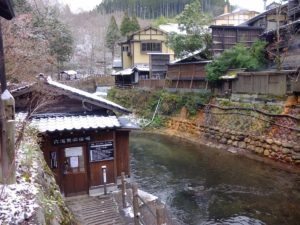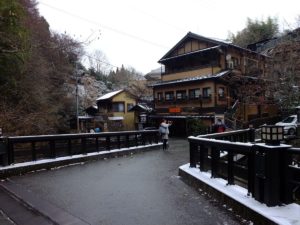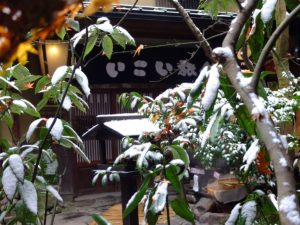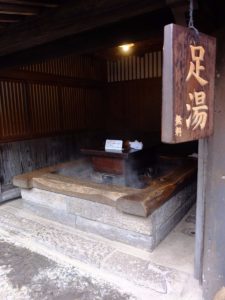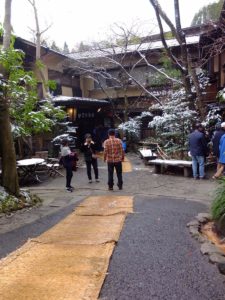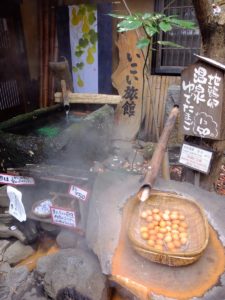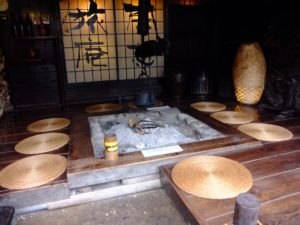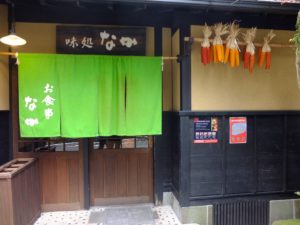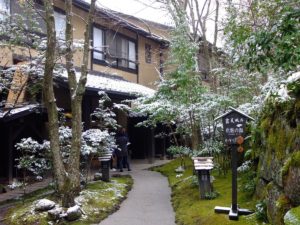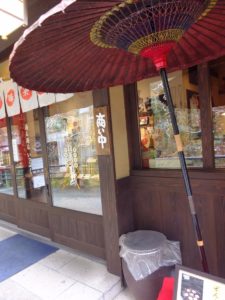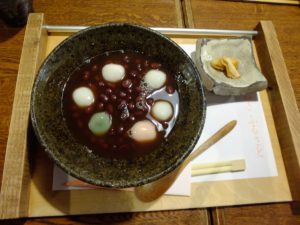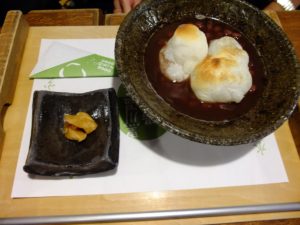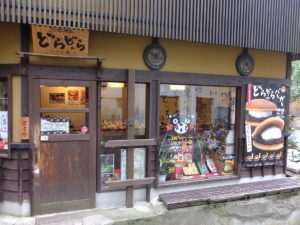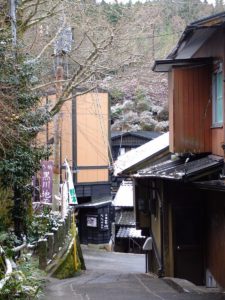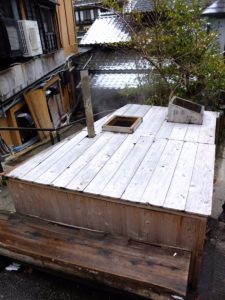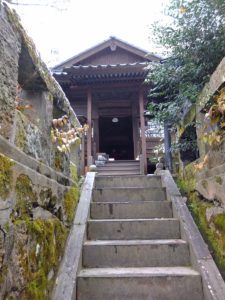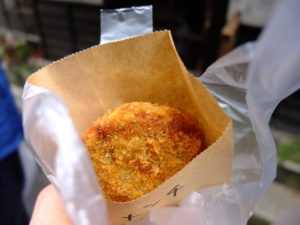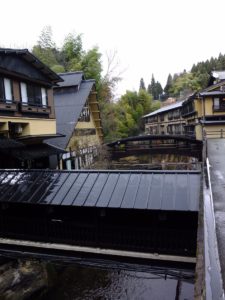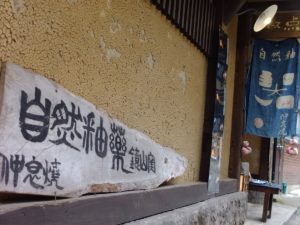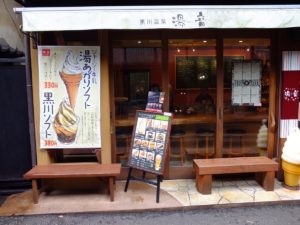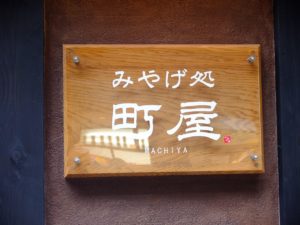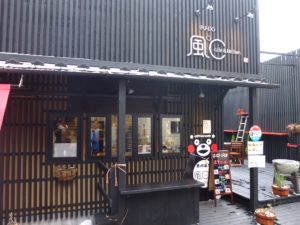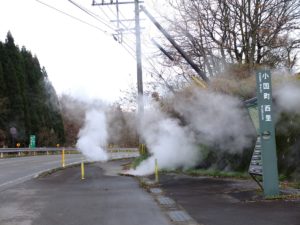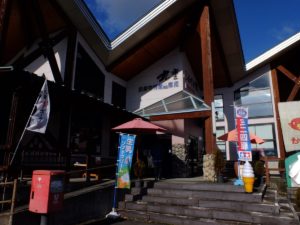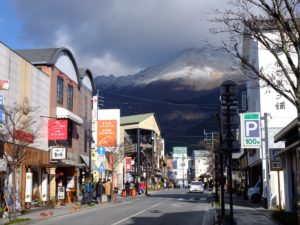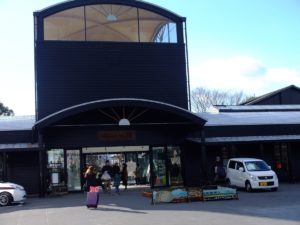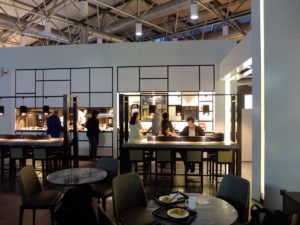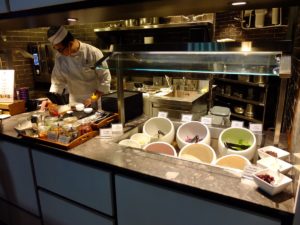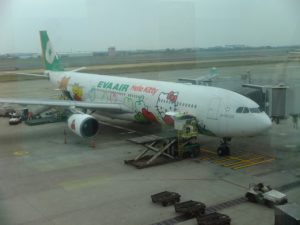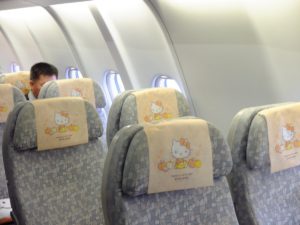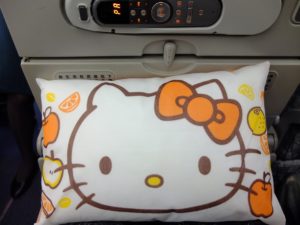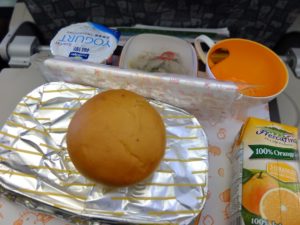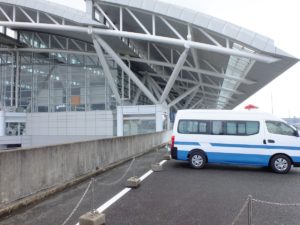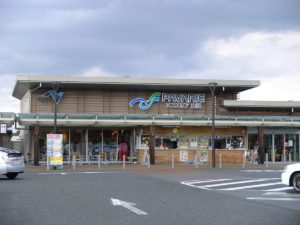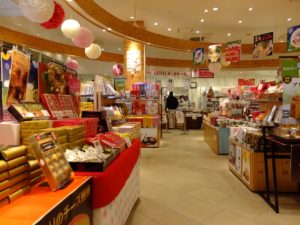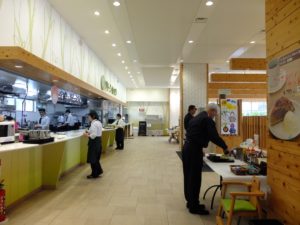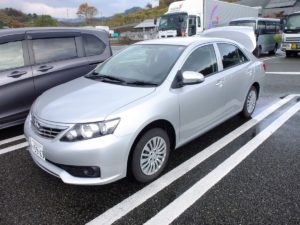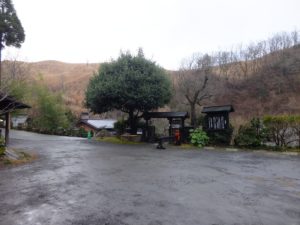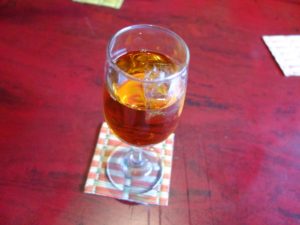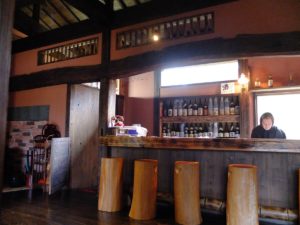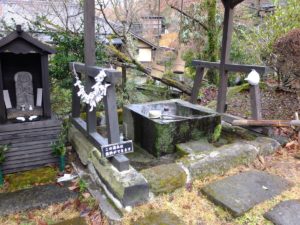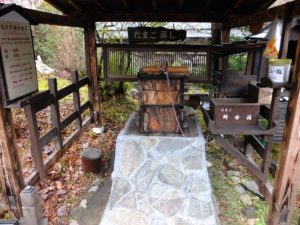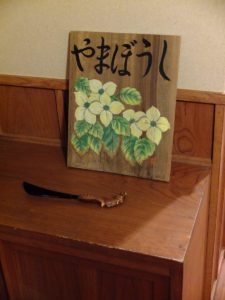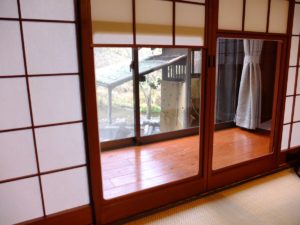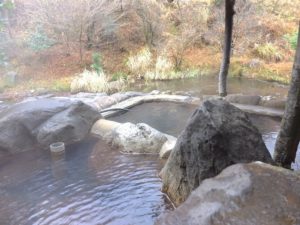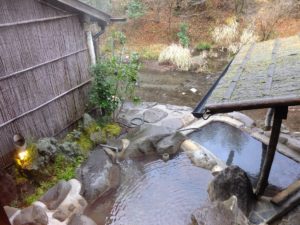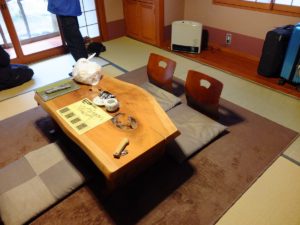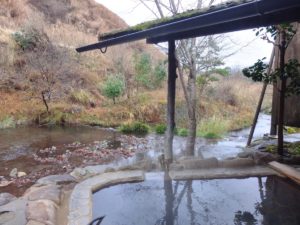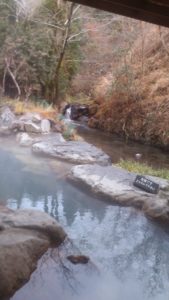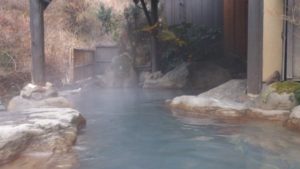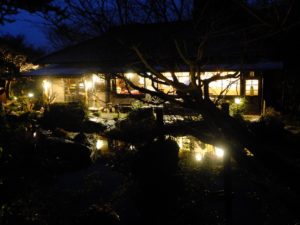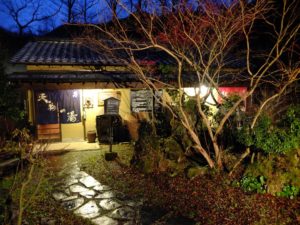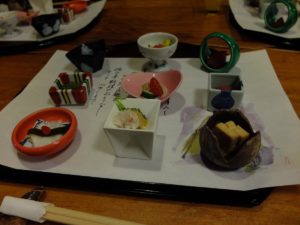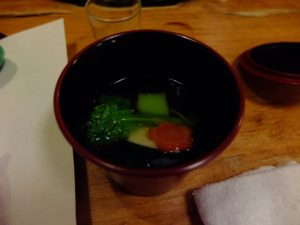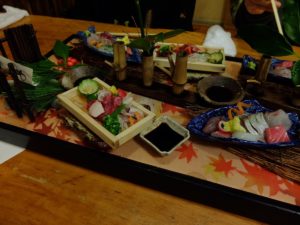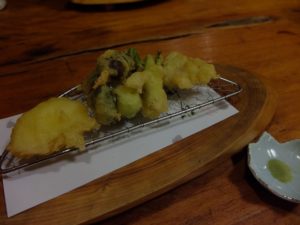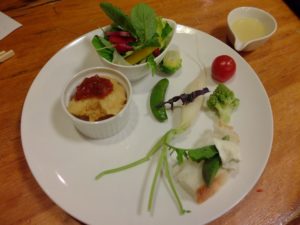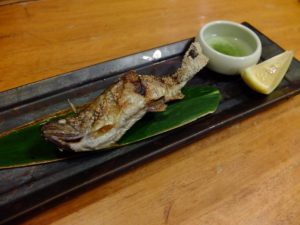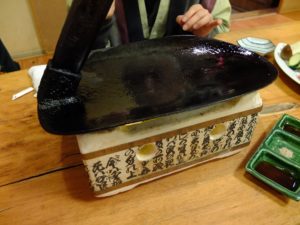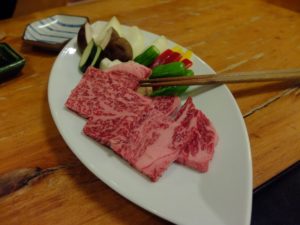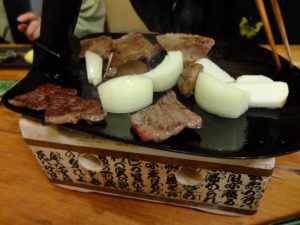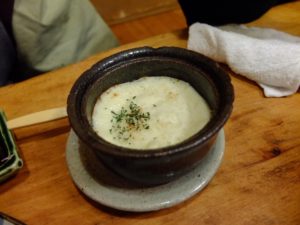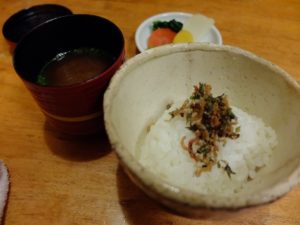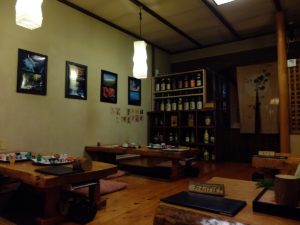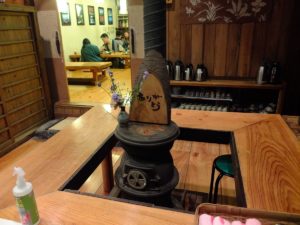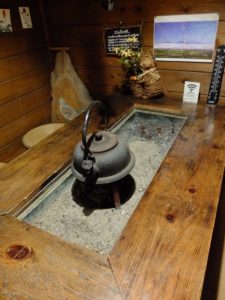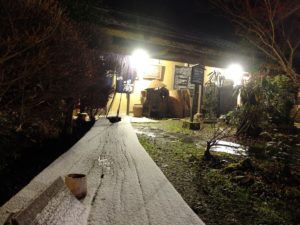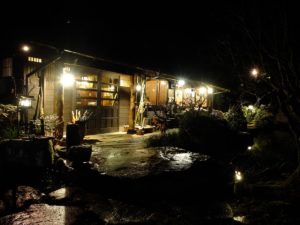We had to return the car by noon, since there was still time we headed for a lookout that looked over the township.
車子必須中午前還,還有點時間,先繞去俯瞰城鎮的瞭望台吧。
Only we we had to quickly turn back to Ryu no Hige since I had forgotten to return the sewing kit we borrowed. Created some confusion since they were readying the vans to drive the other guests to Yufuin station and the road was narrow. After that we were truly on our way.
不過在此之前得先調頭回龍之鬍鬚一下,我忘了還借的針線盒了。這時他們正準備交通車送其他住客去車站,在狹展的小路錯車造成了一些混亂。在這之後才真的上路。
The lookout was a short way up the side of Mt Yufu. Unfortunately it seemed to have been damaged in the earthquake and was cordoned off, so we could only park on the side temporarily and look down from the entrance to the lookout area. The grey township was sandwiched between checkered rice farm paddies, the crop had been harvested so it was all a little grey and brown, in the other seasons the contrast will be brighter. This was supposed to be a good spot to view the morning fog that often shrouds the town, at this hour late in the morning however the view was clear.
瞭望台在由布岳山往上一點點處。可惜似乎在地震中有點損害被拉上封鎖線,只能把車停在路邊,從瞭望台入口處往下看。灰色的城鎮夾在棋盤似稻田中,已經收割大多是灰色土色混在一起,其他季節會有比較亮麗的對比。這裡是俯瞰時常籠罩由布院的晨霧的最佳地點,不過此時已有點晚,沒有一絲霧氣。
The side of Mt Yufu was covered in a thick tall fields of silver grass. The white tails wagged and danced, a expanse of gentle wilderness.
由布岳的山邊長滿了濃密的芒草。白色芒花尾巴搖擺舞動,一片溫馴的荒野。
We drove back down to return the car. The Budget Rental in Yufuin is also the petrol station they suggested we fill up on before returning, quite convenient (I believe the rule was you had to show receipt of having filled up within 5k of the return location), while the tanks were being filled up the Budget Rental staff was already inspecting the car. Before I had even paid the petrol the car was already signed off and returned with lightning efficiency. With the full insurance package there really wasn’t the need for the staff to do more than make a cursory look, any scratch and damages were their responsibility. (But if you knowingly had an incident/accident you still had to call them, otherwise insurance doesn’t apply, it’s just for minor stuff that might have been sustained without you being aware need not be argued over)
我們開回山下還車。由布院的Budget租車也正是機場店建議我們還車前加油的加油站(規定是必須出示還車地點5公里內加滿油的收據),挺方便的,當車子加油時Budget的員工就已經在檢視車子了。我還沒付油錢車子就已經超有效率地閃電般簽收完畢。不過也是因為買了全險,他們也只需要稍微確認沒大狀況就夠了,刮痕損傷都不關我們的事。(但若車子真有意外還是必須聯絡店家警察,不然保險不支付,只是在可能不知情形下受的損傷不會跟你斤斤計較)
Kind of sad to see the car leave, it was a trusty and comfortable drive and stored our luggages well no matter where we went, like we had to worry about now. We drop off our luggage at the store in front of the station (3 pieces for 1100Y) and begin our tour of Yufuin.
看到車子開走有點失落,它性能不錯,開起來很舒服,不管到哪也不用擔心我們現在需面對的行李問題。把行李拖到車站前的特產店寄放(3個1100Y)後,我們的由布院之旅正式開始。
Yufuin is another onsen town that avoided Japan’s lost decades (though it made most of it during the bubble era and slowed to a more gradual growth afterward, whereas Kurokawa made most of its growth after). The town adopted strict building codes such as height limits, which prevented construction of large hotel complexes. Sizes of ryokans were kept small (but not as small as Kurokawa) and the town evolved into a Karuizawa like feel to it, with the main street lined with all sort of cafes, sweets, snacks, trinket and craft shops. The town is also home to a number of art galleries, giving it a claim of having an air of refined taste.
由布院也是逃過日本失落歲月的溫泉街之一(不過主要成長是在泡沫時期,之後便大幅減緩,反觀黑川的成長大多是在近30年,泡沫瓦解後)。小鎮建立了非常嚴格的建築法規,如建築物高度等,防止大型旅館設立,成功的保存了小鄉村的氣息。大多旅館的規模不大(但也沒黑川的那樣小),街市小店林立的發展模式使由布院又有小軽井沢的暱稱,主街上滿是咖啡館,甜點小吃,小紀念品和手工藝店。鎮上也有數家美術館,自許多添一筆高雅品味。
Together with Kurokawa, the two onsens form a symbiotic relationship due to their close proximity (about an hour apart) and similarly small town feel. Though Yufuin is much larger, has access to train line, expressway, closer to Oita a major city; it sees four times as many visitors(~4million) and a magnitude more spend per person because it has so many more shops.
加上黑川,兩個相隔不遠打的同是小鎮氣氛的溫泉,形成相輔的共生關係。不過擁有鐵道,高速公路,接近大分都市的由部院規模大的多了; 每年的訪客數為黑川的4倍(400萬),同時因商店數量的差異,平均消費也相差數倍。
Yufuin is a paradise if you’re into shopping or trying various foods (or hell, from a different persective). I’m not too into snacks or desserts so we mostly browsed, stopping occasionally for dad to do some sample tasting. Even though there are many shops, most of them maintained a visually unobtrusive, harmonious profile. There are little nooks and alleys, hidden shops and cafes tucked away behind the busy main street for the adventurous.
由布院對愛逛街嚐美食的人是天堂(或地獄,另一層面上)。我對甜點小吃不是太有興趣所以大多時只是隨便看看,碰到有試吃的就停下讓老爸嚐嚐鮮。雖然店鋪很多,外觀上大多維持不突兀,能融合一起。有許多轉角巷弄,遠離大街紛擾的隱藏小店或茶點鋪,適合愛冒險的人挖寶。
The yummy sweets offered at Ryu no Hige is from Akashikashiho (赤司菓子舗), its main store is just opposite the bus centre near the train station. It also has a second store further along just before crossing the stream that runs through town. We leave the buying till later to not burden ourselves.
在龍之鬍鬚吃到的甜點是赤司菓子舗的招牌力作,本店就在車站附近的巴士中心對面。另外再往金麟湖一點在過橋前還有一家分店。避免會需大包小包拿來拿去,我們決定把採購留到下午。
Though the main street is impressive by themselves, there are two blocks worthy of mention. The Yu no Tsuba Yokochou (湯の坪横丁) which is a small loop alley with shops built uniformly in the style from the Edo era, and the Floral Village which mimics the looks of a some small British town with low buildings adorned with flowers, retro signages and facades. In the Floral Village there is also an Owl forest where one could see owls up close and supposedly dress up in a wizard robe (I didn’t go in though).
主街已經很夠看了,不過還有兩個區域值得一提。一是湯の坪横丁,一個繞U字一圈的小巷,全部的店皆仿造江戶時期的風格建造。另一是仿英國小村風的Floral Village,一間間用花點綴的矮小屋子,復古的招牌和外貌裝飾。在Village中還有一個貓頭鷹森林,裡頭可以近距離觀賞貓頭鷹,好像還可以穿巫師袍過過癮 (我沒進去)。
The 1.5k walk to Kirin Lake took us about an hour and half. The lake was so named because both cold spring water and hot onsen water wells up from the bottom, this temperature difference causes a glittering effect with the sunset.
到金鱗湖1.5公里的路程走了大約一個半小時。之所以叫金鱗湖是因為湖中同時湧出溫泉和冷泉水,溫度差異在夕陽時形成亮晶晶的效果。
We have lunch at the Marc Chagall cafe on the lakeshore. The burger was okay. There were plenty of restaurants in Yufuin but it would have required backtracking and joining long lines.
午餐是在湖岸邊的Marc Chagall咖啡館。漢堡味道還好。雖然由布院有很多餐廳但一來需要走回去,二來要排隊。
After lunch I split up with my parents, each off to explore on our own. I decide to check out the Marc Chagall gallery upstairs. On display was a collection of painting with the theme of circus. Chagall had a slightly modern style, using rough brush strokes and large exaggerated features, almost newsprint comic like.
午餐後我和爸媽分開行動,各自去探索。我首先決定看看樓上的Marc Chagall藝廊。目前展出的是以馬戲團為主題的一系列畫作。Chagall的畫風相當現代,在粗筆下誇張的詮釋表情動作,接近報紙漫畫的效果。
By Lake Kirin was the Shitanyu, a mixed gender public onsen where one could take a dip for just 200Y. On the southern shore was a shrine with a torii in the lake, reminiscent of the torii of Miyajima in Hiroshima.
金鱗湖旁是下ん湯,混浴的公共溫泉浴場,只要200Y就可以享受。在南岸的天祖神社有一個鳥居樹立在湖水內,有廣島的宮島大鳥居的感覺。
Our cake reservations with B-Speak had to be picked up before 3:30. I took a detour through the backstreets of Yufuin on my way back, Yufuin’s ryokans and hotels tended to be situated away from the main street, dotted amidst the rice paddies. Juggling development while keeping the farmland feel is a top concern for the local government.
跟B-Speak預訂的蛋糕卷必須在3:30前拿。回去的路上我稍微繞了下,由布院的旅館大多分散在離主街一兩條街外的農田間。發展觀光的同時如何保持農村氣息是當地政府正面臨的一大考驗。
B-Speak is Yufuin’s most famous cake shop, operated by Murata, one of the 3 most famous ryokans. Its cakes (at least the ⅓ portion ones) are usually sold by before noon, without prior reservation obtaining a cake can be close to impossible.
B-Speak是由布院最有名的蛋糕店,是由御三家的無量塔開的。他的蛋糕(至少1/3卷的小蛋糕)通常中午前就會賣光,沒有預訂幾乎是買不到的。
Our train departs at 3:50pm, we went to check out another dessert shop close to the station, recommended by the young lady from Ryu no Hige, but everything were already sold out. Even in winter Yufuin is packed with people, the place must be absolutely swamped in summer when people come into the mountains to escape the heat and have ice creams of which Yufuin has plenty.
火車發車時間是3:50。我們繞去離車站不遠處龍之鬍鬚Rika地圖上有提起的泡芙店,但櫥窗已全是空的了。就連在冬天由布院依然是人潮洶湧,在夏天肯定更是人擠人,這裡可是避暑聖地,吹著山中的涼風,邊逛邊享受由布院為數眾多的冰淇淋店。
We arrived at the train station before the crowd showed up, each trailing behind them a large luggage filled with souvenirs and sweets.
The station’s waiting room also doubles as an art gallery. To be honest despite Yufuin’s claim, I very much feel its artistry claims were overshadowed by its sweets and desserts. Only a very small percentage of its visitors were probably interested much less visits one of these art galleries. I was certainly the only one there inside Marc Chagall despite the cafe downstairs having a long queue.
到車站後不久,準備搭車的人群開始湧入月台,人人拖著裝滿戰利品的大行李箱。
車站的候車室同時也是一個畫廊。老實說雖然由布院官方想塑造這種形象,感覺藝術的賣點完全被甜點小吃蓋過去了。大概只有極少部份的遊客對美術館有興趣,更不用說實際參觀了。在Marc Chagall時雖然樓下的咖啡館是大排長龍,樓上卻只有我一個人。
The Yufuin no Mori is one of the first tourist trains by JR Kyushu back in 1989, now the rail company operates a dozen tourist trains throughout Kyushu to boost patronage for lines that would otherwise see very few passengers.
由布院之森是JR九州在1989年開始營運的第一輛觀光火車,現在他們在九州有多至十多種觀光火車,來提升搭乘人數少的路線的營收。
The Yufuin no Mori has elevated seating level and large windows to allow passengers to enjoy the scenery outside. The interior makes use of wood to give the whole train a forest like feel. The first generation trains also sports a lounge area with bench seats facing the windows directly and space for one to stand around, chat with a friend, all while enjoying a drink bought from the shop the next car down. (The second generation trains are newer, has brighter interiors but forgo the lounge space for more seats)
由布院之森有挑高的車廂和特大窗戶好讓旅客欣賞沿途的風景。內部各處使用木頭,想讓人有坐在森林中的感覺。第一代列車還有一個觀景車廂,有面朝窗戶的座位還有站立空間,可以從鄰近的餐車買杯飲料來在這和朋友聊天。(第二代車比較新,內裝比較明亮但犧牲了觀景車廂換取更多座位)
The onboard shop sells a limited ekiben only available on the train, other snacks and drinks such as Aso milk. B-Speak rolls are also available, if they haven’t sold out already.
餐車有賣由布院之森的限定便當,其他點心和飲料,如阿蘇牛奶。也有賣B-Speak蛋糕,若還沒賣完的話。
As the whole train is reserve seat only it can be hard to get a ticket if one walk up to the counter on the day, or even a few days before. The train we took was completely sold out at least 3 weeks earlier (I booked the seat the moment they went on sale a month prior to departure). The 3:50 train is one of the most popular one as it is the most convenient after a day of sightseeing. The later train that leaves at 5pm still had some seats when we left.
由於整輛車都是指定席,發天當天或甚至發車前幾天才去櫃檯買票的話很可能會沒有位子。我們搭的這一班在發車三個星期前就賣光了(我在一個月前一開放買票就訂了)。下午3:50這班車很熱門,一整天逛完由布院後搭時間上再恰當不過。出發時晚一班5點的還有一些位子。
Note that to reserve a seat in advance one must do so online and pay with credit card at time of booking. If one wishes to use a Kyushu JR Pass, then one can only try their luck after entering Japan and go up to a counter in person. Even if I had a schedule that could have saved by using a pass, I probably would still have booked the seats online, paying that extra to have a peace of mind.
注意要提前訂位一定要網上訂票,且訂票時就需用信用卡付。如果想用JR九州pass的話就只能到日本後再親自去票務櫃檯試運氣了。就算行程上能用pass省錢我應該還是會用網路訂票,花錢換心安。
The train was not that impressive, but perhaps it was due to me being tired at the end of the day and also the fading lights making the interior a little dark. The lounge car was a definite plus and I question the decision to forgo it in the generation 2 Yufuin no Mori.
大概是玩了一整天有點累了吧,列車沒有想像中的特別,也可能是時候已晚,車廂內顯得有點陰暗。觀景車廂算是不錯的亮點,覺得第二代列車取消這車廂有點可惜。
During the trip an attendant comes around with a signboard with today’s date on it for passengers to take a photo with it to show they’ve been on the Yufuin no Mori. In the shop carriage there were little train master uniforms for kids to try on and have photos taken.
途中會有列車小姐拿寫有日期的紀念卡牌來給大家合照,證明有搭過由布院之森。在餐車裡也有小車掌制服可給小孩穿上拍照留念。
Overall JR Kyushu definitely tried to make the train ride as unique an experience as possible. Thoughts had also been made with regard to the target audience’s needs; there was wifi on board (speed questionable) and luggage space was plenty at the ends of the carrages.
JR九州確實在許多地方有花心思提升搭車體驗,滿足旅客的需求,車上有wifi(速度不怎麼樣),車廂末端也有放置行李的充裕空間。
The train reached Hakata at about 6:10pm. We navigated the maze that is Hakata station and out the east gate in good time, the benefit of having been to a place before.
到博多是6:10左右。很快的穿過迷宮般的博多車站從東門出去,一個地方曾來過的好處。
Our stay this time is Richmond Hotel, about a hundred metres out and to the right after exiting the station east side. After complaints from my parents about the last trip, this time I went with a little pricier choice. The elevators and rooms are accessed by cards, and each room was spacious (for a business hotel) and had their own aircon control. Power sockets were plentiful and USB chargers were also available. Definitely more comfortable than my usual choices.
這次住的是Richmond Hotel,大概東側出去後往右一百公尺左右。自從上回爸媽反應過後,這回選的稍微貴一點。電梯和房間是用磁卡出入,以商務旅館而言房間算寬廣,也有獨立空調。插座很多,也有提供usb充電。比我一般選的舒服太多了。
After check-in, as I had ekiben on the train already we decided to split up for the night. I brought my parents to the ramen street in Hakata station (note: 2nd floor Deitos on the north east side). I was going to take them to the new KITTE 0101 (note: it’s pronounced Marui) B1 restaurants where I’ve identified a few choice restaurants. My fault for not explaining what the choices were I guess, dad said he wanted ramen and ramen we went.
Check-in後,我在車上已經吃過便當了還不太餓,於是決定分頭行動。我帶爸媽到車站的拉麵街(東北角二樓Deitos)。原本是想帶他們去新開的KITTE 0101 (註:發ma-ru-i)的B1餐廳街,有幾家看來適合的餐廳。不過一開始沒解釋清楚我的計畫,老爸說吃拉麵就好所以就去吃拉麵了。
I helped them order from the ticket machine (ramen ordering machines can be intimidating at first. Can I choose more than 1 item at once? What do I press to get the change?)
我幫他們使用機器買餐卷(拉麵點餐機對第一次用的人還有點難,一次可以點幾樣東西,按什麼找錢?)
Then I’m off to the christmas market in front of the station.
然後我就自己去逛站前的聖誕市集了。
It has always amused me how Japanese do western holidays better than many western countries. Halloween in Australia is barely alive with a smattering of kids dressing up, as we saw last time Japanese put out Halloween themed products everywhere, cakes, drinks, pumpkins in every displays, people dressing up. Valentine? They love it so much they’ve made it into two days, they also switched it around by making it customary for the girl to give the chocolate, and if the guy wished to reciprocate, give something back on white valentine.
很有趣的,明明有許多節日是源自西方的,日本人卻比許多西方國家更會慶祝。在澳洲萬聖節只不過是幾個小鬼穿點衣服,大多人幾乎沒有在慶祝的。但如上回來日本所見,日本到處都是節慶裝飾和產品,蛋糕,飲料,櫥窗裡滿是南瓜,一堆人換裝打扮。情人節?他們喜歡到要有兩個,也把習俗轉了一下改成由女方送巧克力,若男方想回禮再在白情人節送東西。
Christmas is no exception. The christmas jingles were on repeat in the shopping streets, department stores tries to outdo each other with decorations, and a big christmas market with wine and beer and food in the station’s courtyard.
聖誕節也不例外。商店街反覆播放著聖誕歌曲,百貨公司在裝飾上互相競爭,車站前擺起充滿啤酒,葡萄酒和美食的聖誕集市,熱鬧極了。
It was almost 8:30pm, I scored a strange roll of sushi for cheap from the stalls below the station’s department store and headed back to the hotel, grabbing a carton of milk from the 7-11 on the way. Japanese milk is awesome.
快8:30時我在百貨地下街的食品區買了一盒特價但不確定是什麼的壽司,回旅館途中又順便在7-11買了一罐牛奶。日本的牛奶可是超好喝的。
A late dinner of sushi, milk and B-Speak rolls for dessert.
宵夜就是這卷壽司,牛奶,點心還有B-Speak蛋糕捲。
